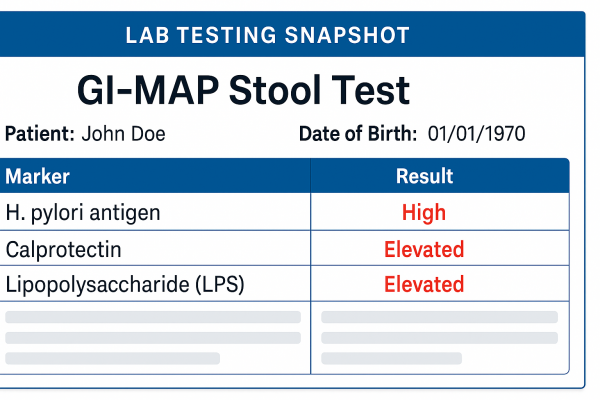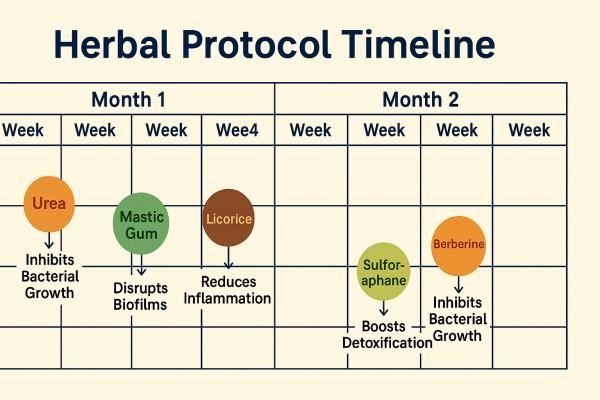
H. pylori (Helicobacter pylori) infects over half of the world’s population, quietly undermining digestion, inflaming the gut lining, and even fueling thyroid autoimmunity. Yet many patients never associate their fatigue, brain fog, low libido, or chronic indigestion with this stealthy bacterium. In this article, we’ll explore what H. pylori is, how it evades conventional treatment, why it wreaks metabolic havoc, and—most importantly—how a functional medicine approach using specialty lab testing and targeted herbal protocols can restore your gut health.

H. pylori is a gram-negative bacterium with two protective cell walls—like a castle behind a moat—making it more resistant to antibiotics than simpler, gram-positive bugs. Between its walls is an efflux pump that ejects many antibiotics, reducing treatment efficacy and causing gastrointestinal side effects.
Once inside your stomach, H. pylori secretes urease, an enzyme that breaks down dietary urea into carbon dioxide (CO₂) and ammonia. Ammonia (pH ~11) neutralizes stomach acid (normally pH 2), impairing:
Protein digestion, by inactivating pepsin and other digestive enzymes
Microbial balance, allowing opportunistic pathogens to flourish
This creates a vicious cycle of dysbiosis, malabsorption, and low-grade inflammation. Over time, the bacterium can erode the protective gut lining, setting the stage for gastritis, peptic ulcer disease, and systemic symptoms far beyond stomach pain.

While textbook signs of gut infections include bloating, gas, diarrhea, and abdominal pain, H. pylori often manifests extra-intestine:
Brain fog and cognitive sluggishness
Fatigue and diminished energy
Mood imbalances
Low libido
Joint or neurological pain
Furthermore, chronic H. pylori infections are linked to a rise in thyroid antibodies, exacerbating autoimmune thyroid conditions (which account for 80–90% of thyroid disorders). Eradicating this infection has significantly reduced thyroid autoantibody levels, protecting your metabolism-regulating gland from immune attack¹².

Directly detects H. pylori proteins in your stool—highly specific and ideal for diagnosing and confirming eradication.
You ingest a labeled urea drink; excess labeled CO₂ in your breath indicates active urease activity (i.e., ongoing infection).
Elevated H. pylori–specific IgM and IgA in blood signal an active infection, complementing stool and breath tests.
Advanced stool panels assess gut microbiome balance, inflammatory markers (e.g., calprotectin), and the presence of endotoxins (lipopolysaccharides), guiding personalized protocols.
By pinpointing the infection and mapping wider gut imbalances, functional medicine empowers you to remove stressors—infections, blood sugar swings, or environmental toxins—so your body’s innate healing capacity can take over.

Conventional H. pylori treatment (e.g., PrevPac™: a proton pump inhibitor + clarithromycin + amoxicillin) lasts 10–14 days but often fails to penetrate the bacterium’s defenses and carries side effects. In contrast, a 60-day herbal protocol:
Bypasses efflux pumps with plant compounds that bacteria haven’t adapted to eject
Gradually wears down bacterial walls and urease activity over weeks
Minimizes dysbiosis, preserving beneficial flora
Reduces endotoxin load, supporting liver detoxification and systemic health
Such protocols typically include blends of Berberis (Berberine), Glycyrrhiza (licorice), Matricaria (chamomile), Mastic gum, and Sulforaphane-rich extracts, each targeting different bacterial survival mechanisms.
Before launching an H. pylori protocol, it’s crucial to optimize your body’s resilience:
Stabilize blood sugar: balance protein, fats, and low-glycemic carbs
Support adrenals: manage stress, prioritize sleep, consider adaptogens
Adopt an anti-inflammatory diet: focus on whole foods, reduce processed oils & sugars
Enhance detox pathways: gentle liver support via antioxidants (e.g., glutathione precursors)
These foundational steps ensure your immune system and detox organs are primed to handle the bacterial die-off (“Herxheimer reactions”) and facilitate smooth recovery.
Ready to reclaim your gut health and protect your thyroid? Dr. J specializes in functional, lab-driven protocols for H. pylori and complex gut infections.
➡️ Schedule your free consult today at www.justinhealth.com/free-consult and discover your personalized roadmap to lasting wellness.
Marshall BJ, Warren JR. Unidentified curved bacilli in gastritis and peptic ulceration. Lancet. 1984;1(8390):1311–1315. PubMed. (First identification of H. pylori and its role in ulcers.)
Niu Y, Zhu C, Cui T, Zhao HL. Meta-analysis: Helicobacter pylori infection and autoimmune thyroid disease. Helicobacter. 2016;21(6):500–508. PubMed. (Eradication reduces thyroid autoantibodies.)
Parsonnet J, et al. Urease activity and pH modulation by H. pylori. Gut. 2002;51(3):303–311. PubMed. (Urease-mediated ammonia production disrupts gastric acidity.)
====================
Recommended Products
====================
Recommended Lab Tests
====================
IN CASE YOU MISSED IT:
H Pylori: How to Identify the Signs and Get the Right Treatment